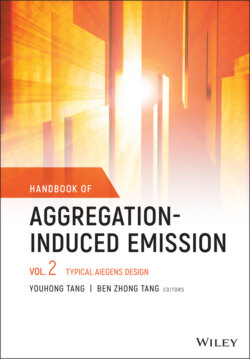Читать книгу Handbook of Aggregation-Induced Emission, Volume 2 - Группа авторов - Страница 22
1.4 Conclusion
ОглавлениеThe study of TPP dated back to the mid‐nineteenth century, while its real structure was established by Japp and Wilson in 1886. Since that, more studies are focused on synthetic methodologies and medicinal chemistry. It is until 2015 that Tang found TPP to be AIE‐active and have merits of easy synthesis, facile medication, good stability, and tunable electronic property, etc. This, therefore, evolves from a variety of functionalities based on tetraphenylpyrazines and makes its researches very attractive.
TPP can be synthesized by cyclization and Suzuki–Miyaura reactions. In the former case, several routes are provided to prepare TPP and its derivatives with mono‐, di‐, and tetrasubstitutions. For disubstituted TPP, the molecules even with substitutions at different sides can be obtained. By choosing a suitable method, TPP can be synthesized under a very simple and green condition and the purification of TPP can be carried out by recrystallization instead of chromatographic column. The Suzuki–Miyaura reaction can also give tetrasubstituted TPP efficiently and replenish the products that cannot be obtained by the former methods. Encouraged by this, a large amount of desired structures based on TPP can be designed.
TPP‐based luminescent materials show different functionalities to indicate their application potentials. Electron‐donating group‐modified TPPs often show high luminescent efficiencies in the aggregate state and can be utilized to fabricate OLEDs, with EQE approaching theoretic limit. By decorating TPP with an active group, the resulting AIEgen can function as a ratiometric fluorescent sensor to detect H2S with good selectivity and high sensitivity. Besides, by constructing TPP derivatives with different isomerization effects, a model can be established to elaborate the influence of molecular conjugation and porosity on the sensing properties. TPP can also catch the eyes of researchers in reticular chemistry. For example, the chiral TPP‐based organic cage can be obtained from the achiral TPP unit, which can form a host–guest complex with ACQ molecules to construct stable white‐light emission materials in the film state. Also, MOFs can be designed based on the TPP unit as ligand, which shows strong emissions due to coordination‐induced emission and antenna effect and displays a sensitive and selective ratiometric detection of arginine.
Overall, the researches on TPP are still in an embryonic stage. Many applications are worth being further explored. For example, pyrazines are widely found in natural products and known as antitumor, antibacterial, diuretic, anti‐TB, and antidiabetic drugs. Hydroxyl‐substituted TPPs are regarded as regulators of estrogen receptors. Thus, it is feasible to develop luminescent drugs and imaging agents to monitor the therapeutic process and life process. On the other hand, functional materials with diversified architectures are very easy to achieve based on TPP. The investigations of TPP‐based macrocycles, organic–inorganic coordinated cages, conjugated microporous polymers, covalent organic frameworks, and hydrogen‐bonded organic frameworks are still blank. We hope, with this chapter, a picture of the past, now, and future of TPP can be clearly painted and more sparks and opportunities can be motivated to boost the development of TPP‐based luminescent materials.
